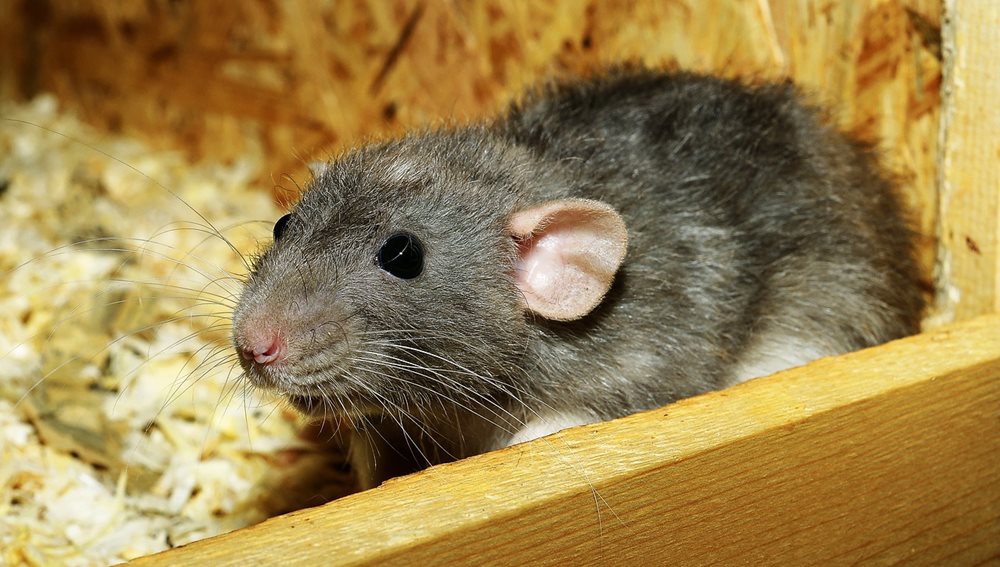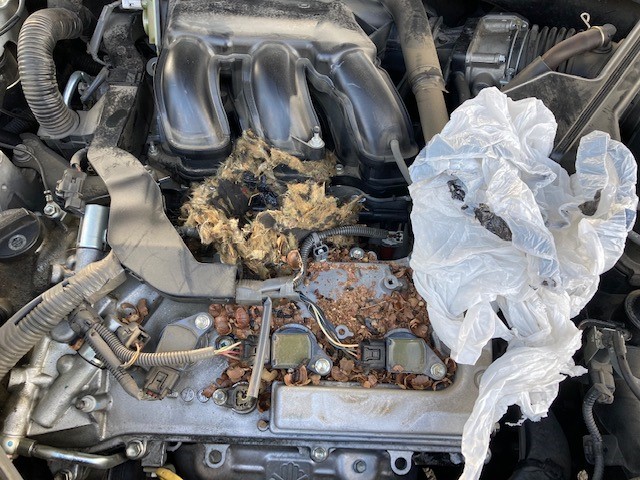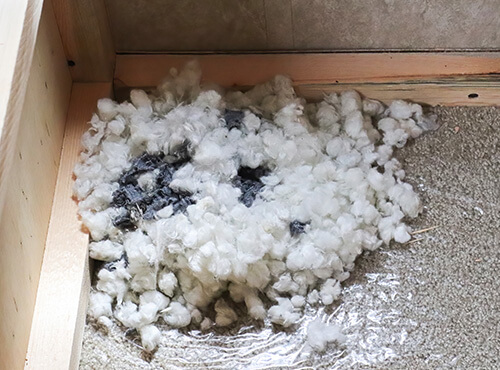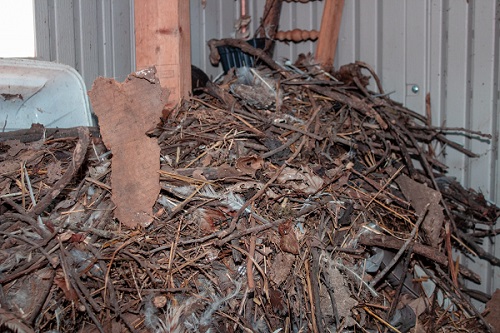
The two rat species most likely to be a problem are Norway rats (brown rats) and roof rats (black rats). Rats typically live in urban or suburban areas if they can acquire access to food sources, water, and shelter. Both pests are nocturnal and hide in their nests during the day.
Preferring to eat around homes, businesses, and restaurants, the small pests an get inside through cracks and holes around the roof, on your walls, and on foundations. Other avenues, such as open doors and windows, floor drains, fan openings, and previously infested merchandise packages, also allow the critters to set up permanent residence indoors.
Norway rats are excellent swimmers and can enter through the sewers. Both species are climbers. Roof rats’ climbing abilities can scale trees, drain pipes, and siding to get onto your roof and inside your home.
Rat Nesting Behavior
Depending on their species, rats may have different nesting behaviors. Roof rats build nests up high and will not hesitate to build a nest in your attic or vents. Norway rats build nests closer to the ground, typically burrowing underground near the edges of your home. They may also enter your basement and crawlspaces.
Rats look for good shelter all year, but as the outside temperatures drop in colder months, they are more likely to try to enter your home.
Have rats in the house?
Find a Critter Control near you
Where Do Rats Live Inside the House?
Rats are creatures of opportunity and will build nests wherever they see a spot that can offer warmth and access to food, water, and materials. You may find a rat living in your attic, building nests using insulation, and other items in storage or lying around. Some rats build nests in the ductwork, making using your heating and air conditioning unit hazardous.
Rat nests in your house may also be found in your walls, ceiling, under appliances, in cabinets, and anywhere else that is dark and secluded, such as
- Eaves
- Crawlspaces
- Basements
What does a rat nest look like? Listen here:
Where Do Rats in Your Yard?
Norway rats build burrows that offer shelter, protection, and access to food and water. These rat burrows are found under vegetation, rocks, logs, or debris. In your yard, you can find rat holes near your foundation, under porches or patios, and sheds. If they gain access to your attic, rats will create rat burrows in the insulation.
Roof rats live high above the ground. In the yard, residents may spot roof rat nests in trees, firewood piles, shrubs, and vines.
Rats are opportunists. They will also nest under your car hood.

What Does a Rat’s Nest Look Like?
The nest may resemble a messy ball-shaped structure or a heap of various materials. A rat nest typically consists of a collection of materials loosely piled up in a hidden location. These materials can include shredded paper, fabric, insulation, leaves, twigs, and other debris found in their surrounding. Homeowners find rat nests in enclosed areas like crawlspaces, cavity wall, in attics, under porches, or in boxed-in plumbing. In outdoor areas surrounding homes, things such as debris piles, yard water, old furniture, ponds, trees, and garbage dumps are inviting to rats, as well.
Photos of Rats’ Nests


Rat Nests vs. Rat Burrows
What does a rat’s nest look like? They are balls of debris you may find in dark, vacant spots inside your home. If the nests are found in high locations, they likely belong to a roof rat. If nests are in your basement or crawlspaces, a Norway rat is the culprit.
Outdoors, Norway rats burrow underground. Burrows are small holes in the ground usually found along the home’s edges, under vegetation, shrubs, and bushes. Looking into the burrow, you will see it looks like a tunnel that is two to four inches wide and 18 inches deep. Some rats burrow multiple tunnels and create a den-like area connecting them all.
Rat Nests vs. House Mouse Nests
Rat and house mouse nests have a few differences. House mice like to be close to their food since they feed up to 20 times daily. They prefer to nest within 30 feet of their food source. Mice prefer to nest in warm areas, particularly under ovens, dryers, heaters, and ductwork. House mouse nests are smaller than a rat’s nest and are most often made of soft materials.
Rats will incorporate hard and soft materials in their nests. Rats tend to nest in hard-to-reach areas, whereas house mice will nest in areas where they are more exposed. Rat nests appear neater and more orderly than mice nests.
How to Find a Rat Nest
If you have noticed signs of rats, how does Critter Control find the rat nest?
- Listen for sounds. Rats are nocturnal so homeowners will hear them at night. Our technicians rely on your experience to start our inspection.
- Look for signs of rat activity like droppings, gnaw marks, rat tracks, and greasy smudges on along the wall.
- Investigate near the rat signs. Rats nest in hidden, dark spaces and typically do not travel far from their nests. Usually rats stay within a radius of about 100 to 150 feet from their nest to find food and water. Areas typically investigated include behind appliances, attics, basements, or in empty boxes.
- Follow the odor. Rats have a distinct musty odor.
Can You Destroy a Rat’s Nest?
Multiple rats live in a nest. When you find a nest in your home, avoid any instincts to pick it up and throw it outside. Doing so poses several risks, like encountering aggressive rats that may bite or scratch you to protect their nest. Rats carry diseases like leptospirosis, hantavirus, and salmonellosis. They contaminate nesting materials with feces and urine, one way they transmit diseases.
It’s essential to understand how to destroy a rat’s nest. It must be done in steps, starting with removing all rats first. Also, to use the correct protective gear.
How to Get Rid of a Rat Nest in Insulation
Effective rat control requires more than a few rat traps. To get rid of rats, you must eliminate why they came to your property, remove access to your house, and finally exterminate the existing pest population.
Rats usually only live to about six months of age in the wild. They reach sexual maturity at around two to three months old. Pregnancies last between 20 and 30 days and typically result in 6 to 12 offspring. Though the rodents possess short lifespans, the rapid rate at which they reproduce, coupled with short gestation periods and large litter sizes, allows rats to continue as formidable pests.
Easily accessible sources of food will bring rats to your yard. Rats are omnivores and can eat almost anything. Rats can find food at bird feeders, pet food left outside, and garbage cans.
Inadequately sealed garages and poor sanitation practices foster ideal conditions for these pesky critters. Appropriate handling of food materials and waste helps deter rats from nesting. People concerned about rat infestations should attempt to rat-proof their homes.
Through exclusion and proper prevention, homeowners can eliminate troublesome rats from building nests inside and around homes.
To begin, openings of 1/4 inch or larger should be blocked with hardware cloth, floor drains should be covered with grates, window screens must fit firmly, and food products should be stored in metal cans with correctly tailored lids.
To exterminate already established invasions, homeowners may utilize traps, bait stations, electronic devices, and cats or dogs to stave off advancements of rodent populations. However, the use of such tactics may not exterminate rat infestations. Concerned residents should contact the professional pest removal experts at Critter Control to take care of any rat issues before they get out of hand.
Learn more about rat removal.
Get them out.
Keep them out.®
Experiencing a wildlife or pest issue? We can help! Complete this form and your local Critter Control® office will contact you to assist.
- Baby Rats
- Do Rat Repellents Work?
- Do Rats Hibernate in Winter?
- Dead Rat
- Rat Droppings
- Diseases from Rats
- Rat Bites
- Rat Life Cycle
- Identify Rat Noises Inside Your Home
- Rat Tracks
- Rat Traps & Baits
- Rat Tunnels in Attic
- Rats in Cars
- Rats in Crawl Space
- Rats in Homes
- Rats in Walls
- Types of Rats
- What Can Rats Chew Through
- What Do Rats Eat?
- What Does a Rat Look Like?